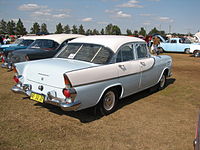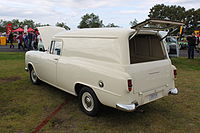Holden FB
| Holden FB | |
|---|---|
 Holden Special Station Sedan | |
| Overview | |
| Manufacturer | Holden (General Motors) |
| Also called | Holden Standard Holden Special Holden Utility Holden Panel Van |
| Production | January 1960 – May 1961 |
| Body and chassis | |
| Body style | 4-door sedan 5-door station wagon 2-door coupé utility 2-door panel van |
| Layout | FR layout |
| Powertrain | |
| Engine | 138 cu in (2.3 L) 6-cyl[1] |
| Transmission | 3-speed manual[1] 3-speed automatic[1] |
| Dimensions | |
| Wheelbase | 105.0 inches (2667 mm)[1] |
| Length | 181.5 inches (4610 mm)[1] |
| Width | 67.0 inches (1703 mm)[1] |
| Height | 60.0 inches (1521 mm)[1] |
| Curb weight | Standard Sedan: 2473 lb (1122 kg)[1] |
| Chronology | |
| Predecessor | Holden FC |
| Successor | Holden EK |
The Holden FB is an automobile produced by Holden in Australia from 1960 to 1961.[2] Introduced on 14 January 1960,[1] the FB series replaced the Holden FC range.[2]
Model range[]
The FB range consisted of four-door sedans in two trim levels, five-door station wagons in two trim levels,[3] a two-door coupe utility and a two-door panel van.[4] The six models were marketed as follows:
- Holden Standard Sedan[3]
- Holden Standard Station Sedan[3]
- Holden Special Sedan[3]
- Holden Special Station Sedan[3]
- Holden Utility[4]
- Holden Panel Van[4]
The Holden Business Sedan, which had been marketed as part of the FC range, was not carried over to the FB series.[2]

Holden Standard Sedan

Holden Standard Station Sedan

Holden Special Sedan

Holden Special Station Sedan

Holden Utility

Holden Utility

Holden Panel Van

Holden Panel Van
Changes[]
The FB was promoted as being longer, lower, more spacious and more powerful than the FC model, but in reality it was only slightly so on each count.[5] Overall length was 5.5 inches (140 mm) greater, although the wheelbase remained the same.[5] The engine bore was still 3 inches (76 mm), the last model with that specification. Engine capacity remained at 132 cubic inches (2.16 L) but the compression ratio was raised. However, the resulting extra 4 brake horsepower (3 kW) of power did not compensate for the greater weight of the FB, so performance was inferior to that of its predecessor.[6] Changes were also made to the brakes, front coil springs, air cleaner and clutch.[2]
Obvious styling differences were the lower bonnet, finned rear mudguards with new taillights (on the sedans and wagons only) and a wrap-around windscreen.[5] Seating was improved, as was the instrument panel.[5]
Notably, the FB was the first Holden model to also be produced in left-hand drive form, those vehicles being destined for export markets.[2]
Engines[]
All FB models were powered by a 132-cubic-inch (2.16 L) inline six-cylinder engine, the last to have the 3-inch (76 mm) bore size, producing 75 brake horsepower (56 kW).[6]
Production and replacement[]
After a production run of 147,747 vehicles,[1] the FB was replaced by the Holden EK series in May 1961.[7]
References[]
| Wikimedia Commons has media related to Holden FB. |
- ^ a b c d e f g h i j Holden FB Specifications Retrieved from www.uniquecarsandparts.com.au on 15 October 2009
- ^ a b c d e Holden FB Retrieved from www.uniquecarsandparts.com.au on 15 October 2009
- ^ a b c d e ”Holden, Australia’s Own Car” (GMH sales brochure for Holden FB Sedans and Station Sedans)
- ^ a b c ”Holden, Australia’s Own Utility, Australia’s Own Panel Van” (GMH sales brochure for Holden FB Utility and Panel Van)
- ^ a b c d Tony Davis, Aussie Cars, 1987, page 78
- ^ a b Original Genuine GMH Factory Workshop Manual
- ^ Holden Heritage Part 1 Archived 24 August 2009 at the Wayback Machine Retrieved from media.gm.com on 15 October 2009
Further reading[]
- Norm Darwin, 100 Years of GM in Australia, 2002, pages 230–231
- Norm Darwin, The history of Holden since 1917, 1983
- The Sixties Holden Archive – Holden FB Retrieved from members.tripod.com on 15 October 2009
- Cars of Australia
- Holden vehicles by series
- Cars introduced in 1960







